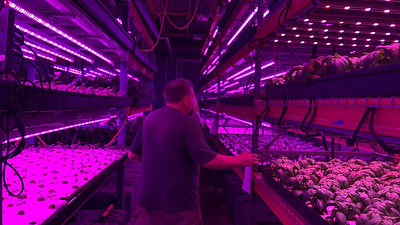If there was ever a place that needs vertical farming, it’s right here in Michigan. Earlier this month, the National Centers for Coastal Ocean Sciences (NCCOS) issued its preliminary annual prediction for the harmful algal bloom (HAB) for Lake Erie this year. Currently, the prediction calls for a bloom severity of between 2 and 6. A bloom with a severity index of 5 will impact the safety of drinking water.
In 2011, Lake Erie experienced its worst HAB on record. In 2003 and 2004, Lake Erie recorded algal blooms with severity indices of 4 and 3 in intensity. By 2008, the severity index exceeded 6 for the first time in recorded history. Although the HABs in 2009 and 2010 remained marginally below 6. Lake Erie recorded a HAB of 10 in 2011, breaking its own severity index record. The HAB severity index remained below 4 in 2012, 2016, 2018, and 2020. In 2013, 2017, and 2019, the HAB approached or exceeded 8. In 2015, Lake Erie once again set a new severity index record of 10.5. The severity index approached or exceeded 6 in 2021 and 2022.
Why is this important? Eleven million people in Ontario, Michigan, Indiana, Ohio, New York, and Pennsylvania rely on Lake Erie to supply drinking water. Lake Erie is the shallowest of the Great Lakes. It is most likely to experience harmful algal blooms as the result of runoff from farming activities. The Maumee River in Ohio is the largest single contributor of farming fertilizer to the Lake Erie Watershed.
This isn’t an “Ohio problem.” Because the lakes are all connected to each other and to other waterways, it is an “everybody problem.” One potential solution to reducing the need for farm fertilizers is through the incorporation of vertical farms into the food production cycle.
Now is the time to explore vertical farming programs
Vertical farming requires less space, less water, and less fertilizer than traditional soil-based farming does. Additionally, it minimizes the need for pesticide applications, shortens the growing cycle, and enables food production in highly urbanized areas, where soil contamination would otherwise make agricultural production difficult or impossible.
Vertical farming also enables year-round agricultural production, and all but eliminates the possibility of contamination from E. coli, a common cause of food-borne illness in traditional, soil-based produce. Vertical farming could easily supply food to so-called “food deserts” by transferring food production to areas where fresh food is hard to source. As an added benefit, it minimizes the transportation required to bring food into cities.
WCC has never dabbled in agricultural studies, even though slightly more than 2% of the taxed property in Washtenaw County is classified as agricultural. However, vertical farming is largely an urban activity that has the potential to improve the quality of food available here year-round and give purpose to the county’s vacant commercial space.
To make it work, the area would need a program that includes the agricultural training required to run a vertical farm combined with business classes to help “urban farmers” operate a business.
Vertical farming makes sense for this area, especially if – in the coming decades – we expect to receive a large number of “climate migrants” from other areas of the country. Year-round food production offers one way to cope with the influx of residents. It also may help relieve the dependency on West Coast farming operations, and it may reduce the amount of fertilizer and other farm runoff entering the Great Lakes.
This is the kind of educational programming we need in Washtenaw County.
Photo Credit: Nicolás Boullosa , via Flickr
















